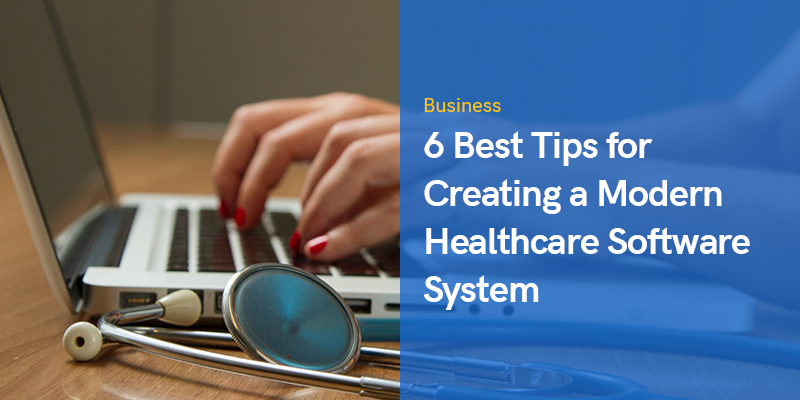
6 Best Tips for Creating a Modern Healthcare Software System
Healthcare is amongst the largest industries on the worldwide market.
Deloitte’s recent Global Health Care Outlook report reveals that the current healthcare industry is worth $7.724 trillion.
For software developers, it means an immense demand for custom healthcare solutions.
Best Tips for Creating a Modern Healthcare Software System
But what are the most trending elements for healthcare software systems today?
CRMs, Billing, E-Prescribing
All modern medical organizations need CRM software healthcare solutions in order to keep and manage all the business records effectively. CRM integration enables:
- electronic accounting and reporting
- integration with payment systems
- patient records management
- electronic scheduling
- email notifications
- custom features
Telemetry and Remote Monitoring
Remote monitoring devices have been already approved for use by the FDA. The COVID-19 outbreak created an extremely high demand for a sufficient development boost in this area to cut the spread of the virus as much as possible. Integration of telemetry and remote monitoring has enough benefits to stay in high demand in the future as well. Here are some of them:
- Early detection – regardless of which part of the body is under remote monitoring, it helps detect potential problems earlier and apply a proactive treatment. If something goes wrong, the systems allow immediate reacting, which is potentially equal to millions of saved lives.
- Healthcare workers’ time optimization – the ability to monitor patients without being near them saves dozens of hours per year.
- Fewer expenses – although the development of a new software system can be very expensive, it will pay off quickly as it can eliminate the need for extra employees. For particular categories of patients, remote monitoring can eliminate the costs of regular hospital stays.
- Immediate discomfort detection – sympathetic nervous system produces signals when the human body experiences pain. Telemetry can deliver these signals to doctors immediately regardless of the patient’s ability to communicate.
- Stress relief for patients – patients who know that they’re connected to their doctors 24/7 can gain extremely important peace of mind, which definitely has a positive impact on most health conditions.
Machine Learning and AI Technologies
Artificial intelligence has already been adopted by many healthcare software systems worldwide for purposes like skin care analysis. The most important benefit of AI is a major decrease in human error. AI automation and machine learning allow delegating huge amounts of paperwork and routine decision-making to computers, mobile devices, and cloud computing systems.
Working with a FHIR vendor can significantly enhance the interoperability of healthcare software systems, allowing for seamless data exchange.
The integration of AI is also expected to improve:
- Preliminary diagnosis
- Drug overdosing elimination
- Fraud attempt detection
- Robot assistance in surgery
Grand View Research reports that the overall AI and machine learning is expected to surpass a $33 billion mark by 2025.
Telemedicine
Meritt Hawkins 2017 survey based on a wide selection of people from 15 metropolitan cities figured out it took almost 1 month for an average patient to get an appointment.
Telemedicine helps to reduce this whopping queue time by connecting patients with doctors through telehealthcare services.
This way, hospitals can also minimize the need for patients to get real-life appointments and save money unless an emergency occurs.
IoT (Internet of Things) and IoMT (Internet of Many Things)
Both IoT and IoMT come as essential elements of telemetry and remote monitoring technologies as they require the implementation of interconnected smart wearable devices. Some of the obvious options include:
- EKG
- ECG
- Glucose meters
- Skin/body temperature meters
- Blood pressure monitors
- Automated drug injection devices
- Fall detection wearables
Document Digitalization
Medical CRM systems worldwide require upgrading to reduce the amount of paperwork to a minimum.
In this digitized era, collaborating with a medical record retrieval company can enhance this process, ensuring that all historical patient data is efficiently digitalized and incorporated into the system.
Document archives entail immense expenses for storage space, while cloud storage systems don’t take space in hospital archives at all, while subscription costs are times lower than rentals.
Hospitals can use the saved space to provide patients with more hospital beds.
This has the potential to create additional workplaces for doctors and increase the maximal hospital capacity.
That’s a valuable upgrade, especially for periods like the COVID-19 pandemic when many hospitals faced a dire lack of space.
Physical paperwork reduction allows to automate a document workflow and reduce hospital expenses on non-medical employees.
Besides, this will reduce the potential number of mistakes in documentation to a minimum.
With unified access to documentation via a protected hospital cloud, medical personnel will have immediate remote access to all health records on the same devices where they receive remote monitoring reports.
Doctors need more time for patients and taking away paperwork from them is a must.
Custom Software Systems Are the Best Solution
It’s quite hard to imagine and implement a unified software system like Google, YouTube, or Facebook for medical organizations.
The medical field is extremely diverse, and even two organizations that work in the same realm might require different software solutions for separate workflows.
Custom software (CS) comes as a solution as it allows designing and maintaining systems adjusted for specific organizations and even users.
Custom solutions can be targeted at a narrow list of functions in order to achieve the highest possible efficiency within medical organizations and even small groups of personnel.
For example, automated booking software that allows clients to self-schedule online is a must. Additionally, these solutions send text reminders and email reminders so patients don't miss their appointments.
In addition, you can opt for direct and uninterrupted maintenance and even purchase proprietary servers for the organization if needed.
For instance, a custom VoIP phone system can be configured to adhere to the HIPAA requirements of the healthcare industry, ensuring that all calls are encrypted and protected from potential breaches.
Similarly, emr software development focuses on creating secure and efficient electronic medical records systems, enhancing the management of patient information and healthcare services.
It can also be tailored to route calls to the appropriate medical departments to optimize the response time and provide enhanced E911 service – a critical feature for patient safety.
Of course, CS development is more expensive than the integration of commercial off-the-shelf software.
It also requires much more development time, and there’s a risk that a software company won’t be capable enough to create a genuinely effective system.
On the other hand, it’s quite easy to circumvent all the potential risks due to the direct availability of first-hand reviews by other organizations that have already implemented modern software systems.
Time for Change?
Due to the current level of IT development, the prices for custom software system development are affordable for medical establishments of different sizes.
The most powerful point that you can deliver to your organizations’ investors is that the amount of savings, in the long run, will exceed the size of investments many times.
Healthcare workers will become more efficient, and more lives will be saved! It’s time to gather a meeting and make a game-changing decision.
Recommended Posts

7 Ways to Make Money Online for Beginners
April 29, 2024

Top 6 Free Windows Screen Recorders for Your Personal Blog
February 8, 2024

Thank you for your blog.
The article provides valuable tips for creating a modern healthcare software system. It offers recommendations for medical device and software development inoxoft.com/industries/healthcare/medical-device-software-development/ , making it a helpful resource for those interested in this field. I recommend reading the article to gain further insights on building contemporary healthcare systems.
Thank you for reading and giving feedback on our article 🙂